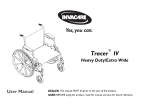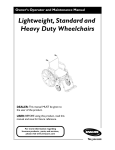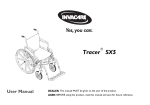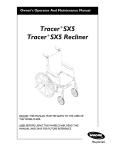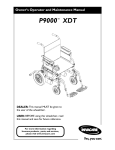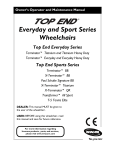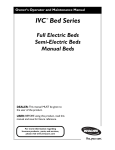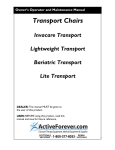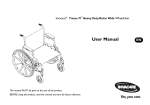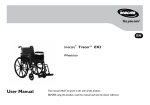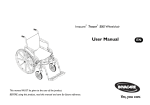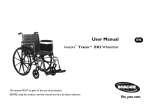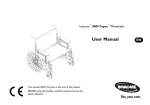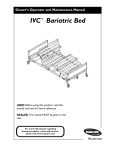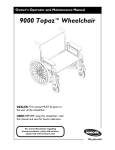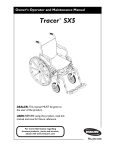Download Veranda™ - Invacare
Transcript
Owner’s Operator and Maintenance Manual Veranda™ DEALER: This manual MUST be given to the user of the wheelchair. USER: BEFORE using this wheelchair, read this manual and save for future reference. For more information regarding Invacare products, parts, and services, please visit www.invacare.com.au WARNING WARNING A QUALIFIED TECHNICIAN MUST PERFORM THE INITIAL SET UP OF THIS WHEELCHAIR. ALSO, A QUALIFIED TECHNICIAN MUST PERFORM ALL PROCEDURES SPECIFICALLY INDICATED IN THE MANUAL. WHEELCHAIR USERS: DO NOT SERVICE OR OPERATE THIS EQUIPMENT WITHOUT FIRST READING AND UNDERSTANDING (1) THE OWNER’S OPERATOR AND MAINTENANCE MANUAL AND (2) THE SEATING SYSTEM’S MANUAL (IF APPLICABLE). IF YOU ARE UNABLE TO UNDERSTAND THE WARNINGS, CAUTIONS, AND INSTRUCTIONS, CONTACT INVACARE TECHNICAL SUPPORT BEFORE ATTEMPTING TO SERVICE OR OPERATE THIS EQUIPMENT - OTHERWISE INJURY OR DAMAGE MAY RESULT. DEALERS AND QUALIFIED TECHNICIANS: DO NOT SERVICE OR OPERATE THIS EQUIPMENT WITHOUT FIRST READING AND UNDERSTANDING (1) THE OWNER’S OPERATOR AND MAINTENANCE MANUAL, (2) THE SERVICE MANUAL (IF APPLICABLE) AND (3) THE SEATING SYSTEM’S MANUAL (IF APPLICABLE). IF YOU ARE UNABLE TO UNDERSTAND THE WARNINGS, CAUTIONS AND INSTRUCTIONS, CONTACT INVACARE TECHNICAL SUPPORT BEFORE ATTEMPTING TO SERVICE OR OPERATE THIS EQUIPMENT - OTHERWISE, INJURY OR DAMAGE MAY RESULT. NOTE: Updated versions of this manual are available on www.invacare.com. Veranda™ 2 Part No. 1148116 TABLE OF CONTENTS TABLE OF CONTENTS SPECIAL NOTES ................................................................................ 5 LABEL LOCATION ............................................................................ 6 TYPICAL PRODUCT PARAMETERS .................................................... 7 SECTION 1—GENERAL GUIDELINES ................................................... 8 Operating Information...............................................................................................................................8 Weight Training ..........................................................................................................................................9 Weight Limitation.......................................................................................................................................9 SECTION 2—SAFETY/HANDLING OF WHEELCHAIRS ......................... 10 Safety/Handling of Wheelchairs.............................................................................................................10 Stability and Balance.................................................................................................................................10 Reaching, Leaning and Bending Forward ........................................................................................11 Reaching, Leaning Backwards ............................................................................................................11 Coping With Everyday Obstacles.........................................................................................................12 A Note to Wheelchair Assistants ........................................................................................................12 Tipping.........................................................................................................................................................12 Tipping - Curbs.....................................................................................................................................12 Stairways.....................................................................................................................................................13 Escalators....................................................................................................................................................14 Transferring To and From Other Seats ..............................................................................................14 Unfolding and Folding Wheelchair .......................................................................................................15 Unfolding................................................................................................................................................15 Folding Wheelchair..............................................................................................................................16 SECTION 3—SAFETY INSPECTION/TROUBLESHOOTING .................... 17 Safety Inspection Checklist.....................................................................................................................17 Inspect/Adjust Initially ...................................................................................................................17 Inspect/Adjust Weekly ..................................................................................................................18 Inspect/Adjust Monthly .................................................................................................................18 Inspect/Adjust Periodically ...........................................................................................................18 Troubleshooting........................................................................................................................................19 Maintenance Safety Precautions ............................................................................................................19 SECTION 4—FRONT RIGGINGS ........................................................ 21 Installing/Removing Front Riggings .......................................................................................................21 Installing..................................................................................................................................................21 Removing ...............................................................................................................................................21 Adjusting Footrest Height ......................................................................................................................22 Raising/Lowering Elevating Legrest Assembly....................................................................................22 Part No. 1148116 3 Veranda™ TABLE OF CONTENTS TABLE OF CONTENTS SECTION 5—ARMS ......................................................................... 23 Removing/Installing Armrests (Removable Armrests Only)...........................................................23 Removing ...............................................................................................................................................23 Installing..................................................................................................................................................23 SECTION 6—BACK ......................................................................... 24 Replacing Standard Back Upholstery ...................................................................................................24 SECTION 7—REAR WHEELS ............................................................. 25 Removing/Installing Rear Wheels .........................................................................................................25 SECTION 8—WHEEL LOCKS ............................................................. 26 Adjusting Wheel Locks ...........................................................................................................................26 LIMITED WARRANTY ..................................................................... 28 REGISTER YOUR PRODUCT The benefits of registering include: 1. Safeguarding your investment. 2. Ensuring long-term maintenance and servicing of your product. 3. Receiving updates with product information, maintenance tips and industry news. Register ONLINE at warranty.invacare.com Please have your model number and purchase date available to complete your registration. Any registration information you submit will only be used by Invacare Corporation and protected as required by applicable laws and regulations. Veranda™ 4 Part No. 1148116 SPECIAL NOTES SPECIAL NOTES Signal words are used in this manual and apply to hazards or unsafe practices which could result in personal injury or property damage. Refer to the following table for definitions of the signal words. SIGNAL WORD DANGER MEANING Danger indicates an imminently hazardous situation which, if not avoided, will result in death or serious injury. WARNING Warning indicates a potentially hazardous situation which, if not avoided, could result in death or serious injury. CAUTION Caution indicates a potentially hazardous situation which, if not avoided, may result in property damage. NOTICE THE INFORMATION CONTAINED IN THIS DOCUMENT IS SUBJECT TO CHANGE WITHOUT NOTICE. WHEELCHAIR USER As a manufacturer of wheelchairs, Invacare endeavors to supply a wide variety of wheelchairs to meet many needs of the end user. However, final selection of the type of wheelchair to be used by an individual rests solely with the user and his/her healthcare professional capable of making such a selection. WHEELCHAIR TIE-DOWN RESTRAINTS Wheelchair users should NOT be transported in vehicles of any kind while in wheelchairs. As of this date, the Department of Transportation has not approved any tie-down systems for transportation of a user while in a wheelchair, in a moving vehicle of any type. It is Invacare’s position that users of wheelchairs should be transferred into appropriate seating in vehicles for transportation and use be made of the restraints made available by the auto industry. Invacare cannot and does not recommend any wheelchair transportation systems. Invacare products are specifically designed and manufactured for use in conjunction with Invacare accessories. Accessories designed by other manufacturers have not been tested by Invacare and are not recommended for use with Invacare products. Part No. 1148116 5 Veranda™ LABEL LOCATION LABEL LOCATION Serial Number Label Location is on crossbraces IMPORTANT NOTICE The wheel locks on this wheelchair have been pre-set at the factory to comply with the Veterans Administration functional Standard 8320.01 of the Federal Register, paragraph 3.2.4.5.3. If these wheel locks do not meet your needs, follow instructions below. ! CAUTION Any wheel lock adjustments should embed wheel lock shoe at least 1/8" into tire when locked (3/16" on pneumatic tires). INSTRUCTIONS FOR WHEEL LOCK ADJUSTMENTS 1. 2. 3. 4. Loosen wheel lock mounting fastener, which runs through mounting bracket and frame. Slide clamp toward rear wheel until wheel lock shoe is embedded into tire material at least 1/8" when handle is engaged to the lock position (3/16" for pneumatic tires). Tighten mounting fastener to secure mounting bracket in desired location and recheck lock shoe embedding. Inspect for correct locking action BEFORE actual use. 00078X021-0394 Crossmember Lower Frame Tube Veranda™ 6 Part No. 1148116 TYPICAL PRODUCT PARAMETERS TYPICAL PRODUCT PARAMETERS VERANDA OVERALL WIDTH: 63.5cm (25 inches) OVERALL DEPTH (WITHOUT FRONT RIGGINGS): 80cm (31½ inches) SEAT WIDTH: 45cm (18 inches) SEAT DEPTH: 41cm (16 inches) SEAT-TO-FLOOR HEIGHT 50cm (20 inches) BACK STYLE: Fixed BACK HEIGHT: 42cm (16½ inches) ARM STYLES: Full or Desk Length Options, Removable FRONT RIGGINGS: Hemi swingaway / Padded elevating legrests, Removable REAR AXLE: REAR WHEELS: Single axle 61cm (24-inch) composite wheel/solid rubber tire HANDRIMS: Composite WHEEL LOCKS: Push to lock CASTER SIZE: 20x2.5cm (8) x1-inch solid rubber UPHOLSTERY: Black nylon FRAME FINISH Silver vein WEIGHT LIMITATION: 250 lbs (114 kg) *NOTE: These heights can vary ± ¼ inch due to tire wear and manufacturing tolerances. Part No. 1148116 7 Veranda ™ SECTION 1—GENERAL GUIDELINES SECTION 1—GENERAL GUIDELINES WARNING SECTION 1 - GENERAL GUIDELINES contains important information for the safe operation and use of this product. DO NOT use this product or any available optional equipment without first completely reading and understanding these instructions and any additional instructional material such as owner’s manuals, service manuals or instruction sheets supplied with this product or optional equipment. If you are unable to understand the Warnings, Cautions or Instructions, contact a healthcare professional, dealer or technical personnel before attempting to use this equipment. Otherwise, injury or damage may occur. Operating Information Unless otherwise noted, all service and adjustment should be performed while the wheelchair is unoccupied. To determine and establish your particular safety limits, practice bending, reaching and transferring activities in several combinations in the presence of a qualified healthcare professional before attempting active use of the wheelchair. DO NOT sit or transfer into the wheelchair unless it is fully open and the seat frame rails are fully seated into the side frame U-blocks. Avoid storing or using the wheelchair near open flame or combustible products. Serious injury or damage to property may result. If equipped, ALWAYS use anti-tippers. When outdoors on wet, soft ground or on gravel surfaces, anti-tippers may not provide the same level of protection against tipover. Extra caution must be observed when traversing such surfaces. DO NOT traverse, climb or go down ramps or slopes greater than 9°. DO NOT attempt to move up or down an incline with a water, ice or oil film. NEVER leave an unoccupied wheelchair on an incline. DO NOT operate on roads, streets or highways. DO NOT attempt to ride over curbs or obstacles. Doing so may cause your wheelchair to tip over and cause bodily harm to you or damage to the wheelchair. DO NOT attempt to reach objects if you have to move forward in the seat. DO NOT attempt to reach objects if you have to pick them up from the floor by reaching down between your knees. DO NOT lean over the top of the back upholstery to reach objects behind you, as this may cause the wheelchair to tip over. DO NOT shift your weight or sitting position toward direction you are reaching as the wheelchair may tip over. Veranda™ 8 Part No. 1148116 SECTION 1—GENERAL GUIDELINES DO NOT attempt to stop a moving wheelchair with wheel locks. Wheel locks are not brakes. DO NOT tip the wheelchair without assistance. DO NOT use an escalator to move a wheelchair between floors. Serious bodily injury may occur. Before attempting to transfer in or out of the wheelchair, every precaution should be taken to reduce the gap distance. Turn both casters parallel to the object you are transferring onto. When transferring to and from the wheelchair, ALWAYS engage both wheel locks. DO NOT attempt to lift the wheelchair by any removable (detachable) parts. Lifting by means of any removable (detachable) parts of the wheelchair may result in injury to the user or damage to the wheelchair. If the wheelchair is exposed to extreme temperature (above 100°F or below 32°F), high humidity and/or becomes wet, prior to use, ensure that the handgrips do not twist on the handle. Otherwise, damage or injury may occur. DO NOT stand on the frame of the wheelchair. DO NOT stand on the footplates. When getting in or out of the wheelchair, make sure that the footplates are in the upward position or swing footrests towards the outside of the wheelchair. ALWAYS use the handrims for self-propulsion. DO NOT grip the rear wheels themselves. ALWAYS keep hands and fingers clear of moving parts to avoid injury. Weight Training Invacare does not recommend the use of its wheelchairs as a weight training apparatus. Invacare wheelchairs have not been designed or tested as a seat for any kind of weight training. If occupant uses said wheelchair as a weight training apparatus, Invacare shall not be liable for bodily injury or damage to the wheelchair and the warranty is void. Weight Limitation The Veranda wheelchair has a weight limitation of 250 lbs (114 kg). Part No. 1148116 9 Veranda™ SECTION 2—SAFETY/HANDLING OF WHEELCHAIRS SECTION 2—SAFETY/HANDLING OF WHEELCHAIRS Safety/Handling of Wheelchairs Safety and handling of the wheelchair require the close attention of the wheelchair user as well as the assistant. This manual points out the most common procedures and techniques involved in the safe operation and maintenance of the wheelchair. It is important to practice and master these safe techniques until you are comfortable in maneuvering around the frequently encountered architectural barriers. Use this information only as a basic guide. The techniques that are discussed on the following pages have been used successfully by many. Individual wheelchair users often develop skills to deal with daily living activities that may differ from those described in this manual. Invacare recognizes and encourages each individual to try what works best for him/her in overcoming architectural obstacles that they may encounter. However, all warnings and cautions given in this manual MUST be heeded. Techniques in this manual are a starting point for the new wheelchair user and assistant with safety as the most important consideration for all. Stability and Balance To assure stability and proper operation of your wheelchair, you MUST maintain proper balance at all times. Your wheelchair has been designed to remain upright and stable during normal daily activities as long as you do not move beyond the center of gravity. Virtually all activities which involve movement in the wheelchair have an effect on the center of gravity. Invacare recommends using seat/chest positioning straps for additional safety while involved in activities that shift your weight. DO NOT lean forward out of the wheelchair any further than the length of the armrests. Make sure the casters are pointing in the forward position whenever you lean forward. This can be achieved by advancing the wheelchair and then reversing it in a straight line. WARNING DO NOT attempt to reach objects if you have to move forward in the seat or pick them up from the floor by reaching down between your knees. Many activities require the wheelchair owner to reach, bend and transfer in and out of the wheelchair. These movements will cause a change to the normal balance, the center of gravity, and the weight distribution of the wheelchair. To determine and establish your particular safety limits, practice bending, reaching and transferring activities in several combinations in the presence of a qualified healthcare professional before attempting active use of the wheelchair. Veranda™ 10 Part No. 1148116 SECTION 2—SAFETY/HANDLING OF WHEELCHAIRS Proper positioning is essential for your safety. When reaching, leaning, or bending forward, it is important to use the front casters as a tool to maintain stability and balance. Reaching, Leaning and Bending Forward WARNING DO NOT attempt to reach objects if you have to move forward in the seat or pick them up from the floor by reaching down between your knees. NOTE: For this procedure, refer to FIGURE 2.1. Position the front casters so that they are extended as far forward as possible and engage wheel locks. FIGURE 2.1 Reaching, Leaning and Bending Forward Reaching, Leaning Backwards WARNING DO NOT lean over the top of the back upholstery to reach objects behind you, as this may cause the wheelchair to tip over. NOTE: For this procedure, refer to FIGURE 2.2. Position wheelchair as close as possible to the desired object. Point front casters forward to create the longest possible wheelbase. Reach back only as far as your arm will extend without changing your sitting position. FIGURE 2.2 Reaching, Leaning Backwards Part No. 1148116 11 Veranda™ SECTION 2—SAFETY/HANDLING OF WHEELCHAIRS Coping With Everyday Obstacles Coping with the irritation of everyday obstacles can be alleviated somewhat by learning how to manage your wheelchair. Keep in mind your center of gravity to maintain stability and balance. A Note to Wheelchair Assistants When assistance to the wheelchair user is required, remember to use good body mechanics. Keep your back straight and bend your knees whenever tipping the wheelchair or traversing curbs, or other impediments. DO NOT attempt to lift the wheelchair by any removable (detachable) parts. Lifting by means of any removable (detachable) parts of the wheelchair may result in injury to the user or damage to the wheelchair. ALWAYS check hand grips for looseness before using the wheelchair. If loose and/or worn, replace immediately. When learning a new assistance technique, have an experienced assistant help you before attempting it alone. Tipping WARNING DO NOT tip the wheelchair without assistance. When tipping the wheelchair, an assistant should grasp the back of the wheelchair on a non-removable (non-detachable) part. Inform the wheelchair occupant before tipping the wheelchair and remind him/her to lean back. Be sure the occupant’s feet and hands are clear of all wheels and/or pinch points. After mastering the techniques of tipping the wheelchair, use the following method to tackle curbs, short stairs, etc. Tipping - Curbs NOTE: For this procedure, refer to FIGURE 2.3 on page 13. Place foot on the step tube and begin to tilt the wheelchair toward you. Apply a continuous downward motion until the balance point is achieved and the front casters clear the curb. At this point, the assistant will feel a difference in the weight distribution. Veranda™ 12 Part No. 1148116 SECTION 2—SAFETY/HANDLING OF WHEELCHAIRS WARNING When lowering the front casters of the wheelchair, DO NOT let the wheelchair drop the last few inches to the ground. This could result in injury to the occupant and/or damage to the wheelchair. Roll the wheelchair forward and slowly lower the front of the wheelchair in one continuous movement onto the sidewalk. Push the wheelchair forward until the rear wheels roll up and over the curb. Step Tube FIGURE 2.3 Tipping - Curbs Stairways WARNING DO NOT attempt to lift a wheelchair by lifting on any removable (detachable) parts. Lifting by means of any removable (detachable) parts of the wheelchair may result in injury to the user or damage to the wheelchair. ALWAYS check hand grips for looseness before using the wheelchair. If loose and/or worn, replace immediately. EXTREME caution is advised when it is necessary to move an occupied wheelchair up or down the stairs. Invacare recommends that, if possible, the user be removed from the wheelchair prior to moving. Invacare recommends using two assistants and making thorough preparations. Make sure to use only secure, non-detachable parts for hand-held supports. NOTE: For this procedure, refer to FIGURE 2.4. Follow this procedure for moving the wheelchair between floors when an elevator is not available: 1. If necessary, rotate the anti-tippers so the wheels are facing up. 2. After the wheelchair has been tilted back to the balance point, one assistant (in the rear) backs the wheelchair up against the first step, while securely grasping a non-removable (non-detachable) part of the wheelchair for leverage. FIGURE 2.4 Stairways 3. The second assistant, with a firm hold on a non-detachable part of the framework, lifts the wheelchair up and over the stair and steadies the wheelchair as the first assistant places one foot on the next stair and repeats STEP 1. Part No. 1148116 13 Veranda™ SECTION 2—SAFETY/HANDLING OF WHEELCHAIRS 4. The wheelchair should not be lowered until the last stair has been negotiated and the wheelchair has been rolled away from the stairway. 5. If necessary, rotate the anti-tippers so the wheels are facing down. Escalators WARNING DO NOT use an escalator to move a wheelchair between floors. Serious bodily injury may occur. Transferring To and From Other Seats WARNING Before attempting to transfer in or out of the wheelchair, every precaution should be taken to reduce the gap distance. Turn both casters parallel to the object you are transferring onto. Also be certain the wheel locks are engaged to help prevent the wheels from moving. CAUTION When transferring, position yourself as far back as possible in the seat. This will help prevent damaged upholstery and the possibility of the wheelchair tipping forward. NOTE: For this procedure, refer to FIGURE 2.5. NOTE: This activity may be performed independently provided you have adequate mobility and upper body strength. Position the wheelchair as close as possible alongside the seat to which you are transferring, with the front casters pointing parallel to it. Remove or flip up the armrest. Engage wheel locks. Swing away or remove front rigging. Shift body weight into seat with transfer. During independent transfer, little or no seat platform will be beneath you. Use a transfer board if at all possible. Veranda™ FIGURE 2.5 Transferring To and From Other Seats 14 Part No. 1148116 SECTION 2—SAFETY/HANDLING OF WHEELCHAIRS Unfolding and Folding Wheelchair WARNING ALWAYS keep hands and fingers clear of moving parts to avoid injury. DO NOT place hand or fingers on the underside of the seat rail when opening or closing the wheelchair. DO NOT sit or transfer into the wheelchair unless it is fully open and the seat rails are fully seated into the side frame H-blocks. Unfolding NOTE: For this procedure, refer to FIGURE 2.6. 1. Tilt the wheelchair toward you (raising the opposite wheel and caster off the ground/floor). 2. Place your hand on the top of the seat rail closest to you where the seat upholstery is attached. 3. Point your fingers and thumb to the inside of the wheelchair. 4. Press downward on the top of the seat rail until the wheelchair is fully open and the seat rails are fully seated in the H-blocks. 5. Engage both wheel locks, open the footrest/legrest for clearance and transfer into the wheelchair. Refer to Transferring To and From Other Seats on page 14. Seat Rail H-Blocks NOTE: DO NOT wrap thumb or fingers under the seat rail. Point fingers and thumb to the inside of the wheelchair. NOTE: Press down on the seat rail and the seat upholstery with the entire hand. DO NOT place any part of the hand under the seat rail. FIGURE 2.6 Unfolding Part No. 1148116 15 Veranda™ SECTION 2—SAFETY/HANDLING OF WHEELCHAIRS Folding Wheelchair NOTE: For this procedure, refer to FIGURE 2.7. 1. Swing footrest/legrest in locked position to the front of the wheelchair. 2. Pivot footplates upward to vertical position. 3. With both hands, grasp the middle of the seat upholstery at the front and back edge and lift up. CAUTION DO NOT allow upholstery to hang between the cross braces. 4. Place excess seat upholstery over the armrest. FIGURE 2.7 Folding Wheelchair Veranda™ 16 Part No. 1148116 SECTION 3—SAFETY INSPECTION/TROUBLESHOOTING SECTION 3—SAFETY INSPECTION/TROUBLESHOOTING NOTE: Every six months or as necessary, take your wheelchair to a qualified technician for a thorough inspection and servicing. Regular cleaning will reveal loose or worn parts and enhance the smooth operation of your wheelchair. To operate properly and safely, your wheelchair must be cared for just like any other vehicle. Routine maintenance will extend the life and efficiency of your wheelchair. Safety Inspection Checklist Initial adjustments should be made to suit your personal body structure and preference. Thereafter follow these maintenance procedures: Inspect/Adjust Initially ❑ Ensure that the wheelchair rolls straight (no excessive drag or pull to one side). ❑ Inspect for loose or missing hardware on frame and crossbraces. ❑ Inspect for bent frame or crossbraces. ❑ Check that the wheel locks do not interfere with tires when rolling. ❑ Check that the wheel lock pivot points are free of wear and looseness. ❑ Check that the wheel locks are easy to engage. ❑ Ensure that the wheel locks prevent the wheelchair from moving when engaged. ❑ Inspect the seat and back for rips and sagging. ❑ Inspect the seat and back for loose or broken hardware. ❑ Inspect the back cane hand grips for wear/looseness/deterioration. ❑ Inspect tires for flat spots and wear. CAUTION As with any vehicle, check the wheels and tires periodically for cracks and wear. Replace if damaged. ❑ Check that there is no excessive side movement or binding in the rear wheels when lifted and spun. ❑ Inspect rear wheels for cracks and wear (hub and rim). ❑ Inspect rear wheels for cracked, bent or broken spokes. ❑ Ensure all spokes are uniformly tight. ❑ Inspect handrims for signs of rough edges or peeling. Part No. 1148116 17 Veranda™ SECTION 3—SAFETY INSPECTION/TROUBLESHOOTING ❑ Inspect axle assembly for proper tension by spinning caster. Caster should come to a gradual stop. ❑ Adjust front casters/forks bearing system if wheel wobbles noticeably or binds to a stop. ❑ Ensure wheel bearings are clean and free of moisture. ❑ Check headtube locknuts for tightness. ❑ Inspect casters for cracks and wear (hub and rim). ❑ Inspect front casters for cracked, bent or broken spokes. ❑ Clean upholstery and armrests. ❑ Check that all labels are present and legible. Replace if necessary. ❑ Ensure the casters are free of debris. Inspect/Adjust Weekly ❑ Ensure that the wheel locks prevent the wheelchair from moving when engaged. ❑ Inspect tires for flat spots and wear. ❑ Inspect rear wheels for cracked, bent or broken spokes. ❑ Inspect axle assembly for proper tension by spinning caster. Caster should come to a gradual stop. ❑ Inspect front caster for cracked, bent or broken spokes. ❑ Ensure the casters are free of debris. Inspect/Adjust Monthly ❑ Ensure that the wheelchair rolls straight (no excessive drag or pull to one side). ❑ Check that the wheel locks do not interfere with tires when rolling. ❑ Check that the wheel lock pivot points are free of wear and looseness. ❑ Inspect seat and back for loose or broken hardware. ❑ Inspect back cane hand grips for wear/looseness/deterioration. ❑ Adjust front casters/forks bearing system if wheel wobbles noticeably or binds to a stop. ❑ Ensure wheel bearings are clean and free of moisture. ❑ Check headtube locknuts for tightness. ❑ Ensure the casters are free of debris. Inspect/Adjust Periodically ❑ Ensure that the wheelchair rolls straight (no excessive drag or pull to one side). ❑ Inspect frame and crossbraces for loose or missing hardware. Veranda™ 18 Part No. 1148116 SECTION 3—SAFETY INSPECTION/TROUBLESHOOTING ❑ Inspect for bent frame or crossbraces. ❑ Check that wheel locks are easy to engage. ❑ Inspect seat and backs for rips and sagging. ❑ Check that there is no excessive side movement or binding in the rear wheels when lifted and spun. ❑ Inspect rear wheels for cracks and wear (hub and rim). ❑ Inspect handrims for signs of rough edges or peeling. ❑ Adjust front casters/forks bearing system if wheel wobbles noticeably or binds to a stop. ❑ Ensure wheel bearings are clean and free of moisture. ❑ Inspect casters for cracks and wear (hub and rim). ❑ Clean upholstery and armrests. ❑ Check that all labels are present and legible. Replace if necessary. ❑ Ensure the casters are free of debris. Troubleshooting Chair Veers Right/ Left X Chair 3 Wheels Sluggish Turn or Performance Casters Flutter Squeaks and Rattles Looseness in Chair X X X X Solutions Check for loose nuts and bolts. Check that rear wheels are equally spaced away from seat frame. X Maintenance Safety Precautions WARNING Unless otherwise noted, all service adjustments should be performed while the wheelchair is unoccupied. After any adjustments, repair or service and before use, make sure all attaching hardware is tightened securely. Otherwise injury or damage may result. Part No. 1148116 19 Veranda™ SECTION 3—SAFETY INSPECTION/TROUBLESHOOTING WARNING When cleaning rear cane or hand grip areas use only a clean towel lightly dampened with cool water. Verify that grips are dry prior to use. Use of soap or ammonia based cleaning solutions will result in the hand grips sliding off the cane assembly. Failure to observe this warning may result in injury to the user or bystanders. Replace any labels that are missing, worn, or torn. Refer to Label Location on page 6 for a listing of the labels and their locations. CAUTION DO NOT overtighten hardware attaching to the frame. This could cause damage to the frame tubing. Veranda™ 20 Part No. 1148116 SECTION 4—FRONT RIGGINGS SECTION 4—FRONT RIGGINGS WARNING After any adjustments, repair or service and before use, make sure all attaching hardware is tightened securely. Otherwise injury or damage may occur. Installing/Removing Front Riggings NOTE: For this procedure, refer to FIGURE 4.1. Installing 1. Turn the front rigging to the side (open footplate is perpendicular to wheelchair). 2. Install the front rigging hinge plates onto the hinge pins on the wheelchair frame. 3. Push the front rigging toward the inside of the wheelchair until it locks into place. Release Lever NOTE: The footplate will be on the inside of the wheelchair when locked in place. Swingaway Footrest 4. Repeat STEPS 1-3 for the opposite side of the wheelchair. 5. To release the front rigging, push the footrest release lever inward, rotate footrest outward. Hinge Pins Hinge Plates Footplate Removing FIGURE 4.1 Installing/Removing Front Riggings 1. Push the release lever inward and rotate the front rigging outward. 2. Lift up on front rigging and remove from the wheelchair. 3. Repeat STEPS 1-2 for the opposite side of the wheelchair. Part No. 1148116 21 Veranda™ SECTION 4—FRONT RIGGINGS Adjusting Footrest Height NOTE: For this procedure, refer to FIGURE 4.2. Upper Footrest Support 1. Loosen, but DO NOT remove, the screw and locknut that secures the lower footrest assembly to the upper footrest support. Screw Lower Footrest Assembly Locknut 2. Reposition the lower footrest assembly to the desired height. 3. Securely tighten the screw and locknut that secures the lower footrest assembly to the upper footrest support. 4. If necessary, repeat STEP 1-3 for the opposite side of the wheelchair. FIGURE 4.2 Adjusting Footrest Height Raising/Lowering Elevating Legrest Assembly NOTE: For this procedure, refer to FIGURE 4.3. 1. To raise the elevating legrest, the assistant or user should hold the support tube and raise the elevating legrests until the desired height is obtained. 2. To lower the elevating legrest, perform the following: A. Support the user leg with one hand. B. Push legrest release lever down with other hand. C. Gently lower user leg down and rest it against the legrest. Legrest Release Lever Support Tube FIGURE 4.3 Raising/Lowering Elevating Legrest Assembly Veranda™ 22 Part No. 1148116 SECTION 5—ARMS SECTION 5—ARMS WARNING After any adjustments, repair or service and before use, make sure all attaching hardware is tightened securely. Otherwise injury or damage may occur. Removing/Installing Armrests (Removable Armrests Only) NOTE: For this procedure, refer to FIGURE 5.1. Removing 1. Press and hold the armrest release button at the front of the armrest. 2. Remove armrest from armrest sockets by pulling straight up on the armrest. 3. Repeat STEPS 1 and 2 for the other armrest. Installing 1. Position armrest over front and rear armrest sockets. 2. Push the armrest down and evenly at both ends until the front release button snaps into arm socket hole. 3. Repeat STEPS 1 and 2 for the other armrest. Armrest Armrest Release Button Arm Socket Arm Socket FIGURE 5.1 Removing/Installing Armrests (Removable Armrests Only) Part No. 1148116 23 Veranda™ SECTION 6—BACK SECTION 6—BACK WARNING After any adjustments, repair or service and before use, make sure all attaching hardware is tightened securely. Otherwise injury or damage may occur. Remove the back for unoccupied transportation purposes only. Securely install the back onto the wheelchair before use. Replacing Standard Back Upholstery NOTE: For this procedure, refer to FIGURE 6.1. 1. Remove the two mounting screws and washers that secure the existing back upholstery to the back canes. 2. Remove the hex screw and locknut that secure one back cane to the wheelchair frame. NOTE: It is necessary to remove only one back cane to replace the back upholstery. 3. Pull the loose back cane out of the existing back upholstery. 4. Pull the existing back upholstery up and over the mounted back cane. 5. Install the new back upholstery over the mounted back cane. 6. Slide the loose back cane through the new back upholstery. 7. Secure the back cane to the wheelchair frame with the hex screw and locknut. 8. Secure the new back upholstery to the back canes with the existing mounting screws and washers. Back Upholstery Mounting Screw Washers Remove Back Cane Mounting Screw FIGURE 6.1 Replacing Standard Back Upholstery Veranda™ 24 Part No. 1148116 SECTION 7—REAR WHEELS SECTION 7—REAR WHEELS WARNING After any adjustments, repair or service and before use, make sure all attaching hardware is tightened securely. Otherwise injury or damage may occur. Removing/Installing Rear Wheels WARNING Only a qualified technician may change the size of the rear wheel or the seat-to-floor height. Make sure both rear wheels are the same size and are installed into the same respective mounting hole before using the wheelchair. Otherwise, injury may occur. NOTE: For this procedure, refer to FIGURE 7.1. 1. Remove the dust cap, hex screw, spacer and locknut that secure the rear wheel to the wheelchair frame. 2. Repeat STEP 1 for the opposite rear wheel. 3. To reinstall the rear wheel(s) onto the wheelchair, reverse STEPS 1-2. 4. Torque the locknut to 40 ft-lbs. 5. Adjust the wheel locks. Refer to Adjusting Wheel Locks on page 26. Rear Wheel Axle Mounting Hole Locknut Wheelchair Frame Dust Cap Spacer Hex Screw FIGURE 7.1 Removing/Installing Rear Wheels Part No. 1148116 25 Veranda™ SECTION 8—WHEEL LOCKS SECTION 8—WHEEL LOCKS Adjusting Wheel Locks WARNING After any adjustments, repair or service and before use, make sure all attaching hardware is tightened securely. Otherwise injury or damage may occur. DO NOT attempt to stop a moving wheelchair with the wheel locks. WHEEL LOCKS ARE NOT BRAKES. NOTE: For this procedure, refer to FIGURE 8.1. 1. Ensure the wheel lock is in the open (unlocked position). 2. Loosen the bolt and locknut that secure the wheel lock assembly to the wheelchair frame. 3. Reposition the wheel lock so that when engaged, the wheel lock shoe embeds the tire 1/8-inch and holds the wheelchair. 4. Securely tighten the bolt and locknut securing the wheel lock to the wheelchair frame. 5. Engage the wheel lock. 6. Measure the distance the wheel lock is embedded into the tire as shown in detail ʺAʺ of FIGURE 8.1. NOTE: Any wheel lock adjustment should embed the wheel lock shoe at least 1/8-inch into the tire when engaged. 7. Repeat the STEPS 1-6 until the wheel lock shoe embeds the tire 1/8-inch and holds the wheelchair. 8. Repeat STEPS 1-7 for the opposite wheel lock. 9. If the measurement of 1/8-inch cannot be achieved, remove the bolt and locknut that secure the wheel lock to the wheelchair frame and mount the wheel lock in one of two mounting positions. 10. Repeat STEPS 1-9 until the wheel lock holds the wheelchair. If the correct measurement still cannot be achieved, contact a qualified technician. 1/8-inch DETAIL “A” WHEEL LOCK SHOE ENGAGEMENT Wheel Lock Shoe Tire Mounting Positions Bolt and Locknut Wheel Lock Handle Wheel Lock Rear Wheel Wheel Lock Shoe Tire FIGURE 8.1 Adjusting Wheel Locks Veranda™ 26 Part No. 1148116 NOTES NOTES Part No. 1148116 27 Veranda™ LIMITED WARRANTY PLEASE NOTE: THE WARRANTY BELOW HAS BEEN DRAFTED TO COMPLY WITH FEDERAL LAW APPLICABLE TO PRODUCTS MANUFACTURED AFTER JULY 4, 1975. This warranty is extended only to the original purchaser/user of our products. This warranty gives you specific legal rights and you may also have other legal rights which vary from state to state. Invacare warrants this product to be free from defects in materials and workmanship for a period of one year from date of purchase. If within such warranty period any such product shall be proven to be defective, such product shall be repaired or replaced, at Invacare’s option. This warranty does not include any labor or shipping charges incurred in replacement part installation or repair of any such product. Invacare’s sole obligation and your exclusive remedy under this warranty shall be limited to such repair and/or replacement. For warranty service, please contact the dealer from whom you purchased your Invacare product. In the event you do not receive satisfactory warranty service, please write directly to Invacare at the address at the bottom of this page. Provide dealer’s name, address, the product model number, date of purchase, indicate nature of the defect and, if the product is serialized, indicate the serial number. Do not return products to our factory without our prior consent. LIMITATIONS AND EXCLUSIONS: THE FOREGOING WARRANTY SHALL NOT APPLY TO SERIAL NUMBERED PRODUCTS IF THE SERIAL NUMBER HAS BEEN REMOVED OR DEFACED, PRODUCTS SUBJECTED TO NEGLIGENCE, ACCIDENT, IMPROPER OPERATION, MAINTENANCE OR STORAGE, PRODUCTS MODIFIED WITHOUT INVACARE’S EXPRESS WRITTEN CONSENT INCLUDING, BUT NOT LIMITED TO, MODIFICATION THROUGH THE USE OF UNAUTHORIZED PARTS OR ATTACHMENTS; PRODUCTS DAMAGED BY REASON OF REPAIRS MADE TO ANY COMPONENT WITHOUT THE SPECIFIC CONSENT OF INVACARE, OR TO A PRODUCT DAMAGED BY CIRCUMSTANCES BEYOND INVACARE’S CONTROL, AND SUCH EVALUATION WILL BE SOLELY DETERMINED BY INVACARE. THE WARRANTY SHALL NOT APPLY TO PROBLEMS ARISING FROM NORMAL WEAR OR FAILURE TO ADHERE TO THESE INSTRUCTIONS. THE FOREGOING EXPRESS WARRANTY IS EXCLUSIVE AND IN LIEU OF ANY OTHER WARRANTIES WHATSOEVER, WHETHER EXPRESS OR IMPLIED, INCLUDING THE IMPLIED WARRANTIES OF MERCHANTABILITY AND FITNESS FOR A PARTICULAR PURPOSE, AND THE SOLE REMEDY FOR VIOLATIONS OF ANY WARRANTY WHATSOEVER, SHALL BE LIMITED TO REPAIR OR REPLACEMENT OF THE DEFECTIVE PRODUCT PURSUANT TO THE TERMS CONTAINED HEREIN. THE APPLICATION OF ANY IMPLIED WARRANTY WHATSOEVER SHALL NOT EXTEND BEYOND THE DURATION OF THE EXPRESS WARRANTY PROVIDED HEREIN. INVACARE SHALL NOT BE LIABLE FOR ANY CONSEQUENTIAL OR INCIDENTAL DAMAGES WHATSOEVER. THIS WARRANTY SHALL BE EXTENDED TO COMPLY WITH STATE/PROVINCIAL LAWS AND REQUIREMENTS. Invacare Corporation www.invacare.com USA One Invacare Way Elyria, Ohio USA 44036-2125 800-333-6900 Canada 570 Matheson Blvd E Unit 8 Mississauga Ontario L4Z 4G4 Canada 800-668-5324 All rights reserved. Trademarks are identified by ™ and ®. All trademarks are owned by or licensed to Invacare Corporation unless otherwise noted. © 2007 Invacare Corporation Part No. 1148116 Rev A - 5/07 ® Invacare Australia 1 Lenton Place North Rocks NSW 2151 Australia. www.invacare.com.au email: [email protected] Phone 1800 460 460 Fax: (02) 8839 5311





























